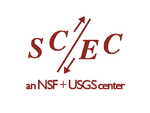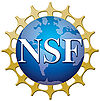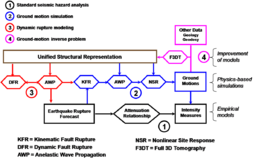Difference between revisions of "Main Page"
| Line 14: | Line 14: | ||
*[[SCEC Scientific Software]] | *[[SCEC Scientific Software]] | ||
| − | == Major Projects == | + | == Major CME-Related Projects == |
*[[UCERF3]] | *[[UCERF3]] | ||
*[[UCVM]] | *[[UCVM]] | ||
Revision as of 04:58, 29 October 2015
Contents
Community Modeling Environment (CME)
This is a collaborative wiki site for SCEC's Community Modeling Environment (CME). The CME is a collaborative, interdisciplinary research group that applies advanced computer science technology to the problem of seismic hazard analysis. This SCEC community wiki is configured to support our distributed research by providing a collection point for information about SCEC scientific computing research projects.
Recently Updated CME Project Entries
SCEC Scientific Software Descriptions
Major CME-Related Projects
- UCERF3
- UCVM
- Broadband Platform
- CyberShake
- High-F
- F3DT
- SEISM2
- Geoinformatics
- CCSP
- CSEP
- Keck CISM
- PRAC
- INCITE
- XSEDE
- USC HPC
- UGMS
- GMSV
- NHERI
- CVM-H
- Ambient Noise Processing
- CFM Fault DB
- Transient Detection
Collaborative Project Entries
The following link will take you to to a list of recently updated SCECpedia pages.
The following link will take you to an alphabetically sorted list of all SCECpedia pages.
The following link will take you to a list of the most frequently visited SCECpedia pages .
Recent Earthquake Information
An important goal of SCEC earthquake research is to reduce the hazard from future earthquakes by developing physics-based predictive models of earthquake processes.
CME Research Support
Southern California Earthquake Center (SCEC) and SCEC/CME research is funded by National Science Foundation (NSF) Cooperative Agreements EAR-0106924 and USGS Cooperative Agreement 02HQAG0008, and NSF awards EAR- 074493, EAR-0949443, OCI-0832698, and OCI-0832698. This research is supported by an allocation of advanced computing resources provided by the National Science Foundation (NSF). Computations are performed at San Diego Supercomputer Center, and the Texas Advanced Computing Center (TACC) at The University of Texas at Austin, the National Center for Supercomputer Applications (NCSA) provide HPC resources. Computations are supported by the University of Southern California Center for Center for High-Performance Computing (HPC). Our research uses HPC resources provided by the U.S. Department of Energy (DOE) through an Innovative and Novel Computational Impact on Theory and Experiment (INCITE) program allocation award. An award of computer time was provided by the INCITE program. This research uses resources of the Argonne Leadership Computing Facility at Argonne National Laboratory, which is supported by the Office of Science of the U.S. Department of Energy under contract DE-AC02- 06CH11357. This research also used resources of the Oak Ridge Leadership Computing Facility, which is a DOE Office of Science User Facility supported under Contract DE-AC05-00OR22725.
See Also
Additional information about SCEC earthquake system science research is available on related SCEC web sites including:
License
Except as otherwise noted, the content of this page is licensed under the Creative Commons Attribution 3.0 Unported License, and code samples are licensed under the Apache 2.0 License. For details, see our Site Policies.
![]()



